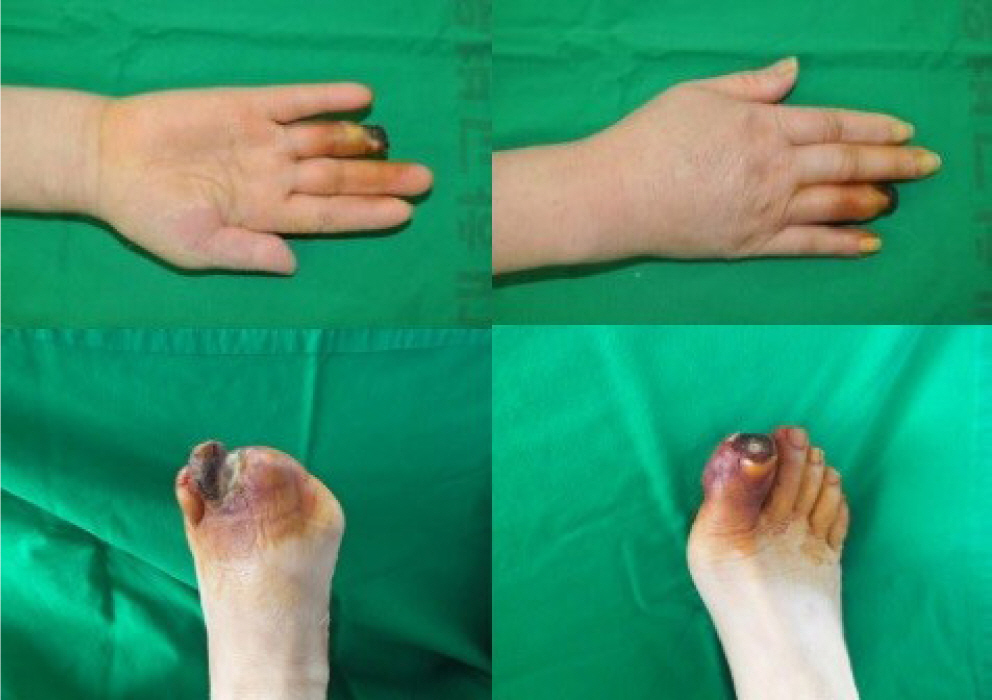| In-Ho Jeon | 4 Articles |
|
[English]

Symmetrical peripheral gangrene is a severe condition marked by symmetric acral necrosis without obstruction of the major blood vessels. This case report examines the critical decisions involved in choosing between early and delayed amputation, as well as determining the extent of the necessary amputation. We present three cases: one involving antiphospholipid syndrome, another with disseminated intravascular coagulation, and a third associated with diabetes mellitus. All three cases ultimately required amputation due to symmetrical peripheral gangrene. In the first two cases, amputation was delayed, which is typically advantageous as it allows for the clear demarcation of necrotic tissue. However, in the third case, where infection was evident, immediate amputation was necessary despite the patient's overall poor health.
[English]
This study aimed to quantify the relationship between proximal humeral rotation and the lateral border of the bicipital groove on fluoroscopic imaging. A composite normal humerus with a marker placed on the lateral border of the bicipital groove was affixed to a custom rotation device at the proximal cut segment. Consecutive fluoroscopic images were captured from −60° to 60° in 5° increments and from −15° to 15° in 1° increments. The index value was calculated by taking the ratio of the distance from the medial boundary of the proximal humerus to the lateral border of the bicipital groove to the distance between the medial and lateral boundaries of the proximal humerus. The correlation between the humeral rotation and the index value was determined. The index value showed a strong positive linear correlation position during internal rotation of the humerus across the entire range (r=0.998, P<0.001), as well as when the humerus was externally rotated, ranging from 15° of internal rotation to 15° of external rotation (r=0.991, P<0.001). The lateral border of the bicipital groove may serve as a useful intraoperative landmark for assessing proximal humeral rotation. This could potentially enhance the outcomes of humeral fracture repair and upper arm arthroplasty.
[English]
ABSTRACT
The review article explores recent advances in the surgical treatment of elbow pain, a common ailment that can significantly impair daily functioning. With a surge in elbow-related conditions such as tennis elbow, osteoarthritis, and nerve compression disorders, the necessity for surgical approaches has become paramount. This article provides an overview of the cutting-edge procedures now available, including minimally invasive arthroscopic surgery. These modern methods have been shown to significantly reduce recovery times and improve overall patient outcomes. The combination of surgical management and targeted rehabilitation ensures a comprehensive and personalized treatment plan for patients with various elbow pathologies. This article aims to shed light on these recent surgical interventions and their potential for advancing the management of elbow pain, emphasizing the ongoing trend toward precision, efficiency, and patient-centered care. Citations Citations to this article as recorded by

[English]
ABSTRACT
The elbow joint, with its intricate anatomy, plays a pivotal role in the upper limb's functional movements. Common surgical indications include epicondylitis, osteoarthritis, tendon tears, and neuropathies. Irrespective of the nature of surgery, appropriate postoperative rehabilitation is essential to enhance recovery, optimize functional outcomes, and minimize complications. Protective measures for the elbow vary based on the surgical procedure is performed. Extended postoperative immobilization is generally not advised. Temporary splints may be utilized to protect the soft tissues in the immediate aftermath of surgery, with patients advised to intermittently remove them to facilitate elbow movement. To increase mobility while ensuring the safety of repaired tendons or ligaments, articulated dynamic braces are recommended. This review delivers clinically useful recommendations specific to various surgical procedures, designed to be user-friendly even for non-specialists in orthopaedic surgery.
|
|

